Epson EMP-TW700 HD Projector Review
Epson EMP-TW700 HD Projector
HD Projectors are now eminently affordable. Is it time to build that Home Cinema?
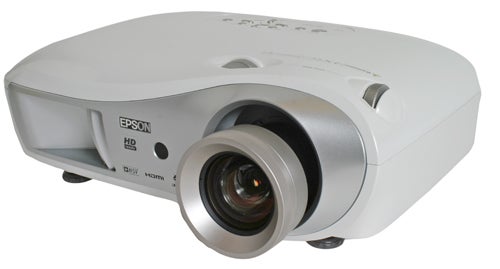
Verdict
Key Specifications
- Review Price: £1090.00
I have a dream. This dream involves a garage, a set of large speakers, a large screen, a projector, and a tub of the world’s best popcorn. We’re talking Home Cinema.
It is in this kind of environment that I hope, one day, to be able to immerse myself in films and games the way they’re meant to be. Of course, there’s always going to be something to be said about going to a public cinema – but usually what you get from the experience are the precise details of Sharon’s date with Dave, and a chance for you to sample that fantastically interesting ring tone that Kevin downloaded last week. What really gets my goat though is that the instant the credits appear at the end people leap out of their seats and bolt for the door like they’ve just remembered that they’ve left the oven on, with any emotional impact that the director has been attempting to build for the last two and a half hours clearly having as much impact as Steve McClaren’s half-time team talks.

Therefore, if you do have a room that you can, at least in part, dedicate to the task, a home cinema is what you need – and a real home cinema means a projector. Of course, it’s not just great for films – games both from console and PC will look amazing on a large screen. While prices for HDTVs are dropping like stones, you still won’t get anywhere near the price to screen size ratio that you’ll get from a projector. A case in point is the EMP-TW700 from Epson, which delivered a 70in image from less than two metres. How much would that cost from a plasma I dare to think.
What’s more, you can get so much projector for your money these days. Toshiba’s MT500, that we reviewed back in January 2004, cost over £2,500 at the time and you only got a DVD optimised 1,024 x 576 resolution.
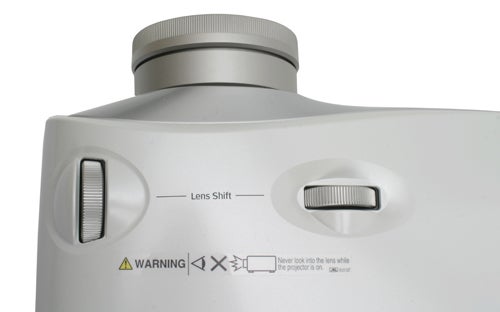
The TW700 is based on Epson’s 3LCD technology, which stands as the main rival to Texas Instruments DLP. Light from the lamp is shone though three separate high-temperature polysilicon LCD panels, a red, green, and blue, and the image then recombined before being projected outwards by the lens. There’s a cool animation of this affect on the Epson website. Epson claims that 3LCD gives a better image than DLP, as each colour is present the whole time in the image, as opposed to DLP, which uses tiny rotating mirrors into fooling the eye that the colours are always there, leaving it susceptible to the ‘rainbow’ image that some users claim to see. I think of it as the difference between a progressive and an interlaced image, but in terms of colour.
However, as the light has to pass through each polarising filter and substrate, LCD projectors tend to be less bright than DLP, and the latter is the technology used in digital cinemas. In practice LCD technology tends to be cheaper, making higher quality and resolution projectors more accessible, which certainly plays a part in its popularity.
That said the 1,600 ANSI lumens rating is on the bright side. In fact, the specs from the TW-700 are rather tasty. The native resolution of the LCDs are 1,280 x 720 – standard HD. Epson’s EMP-TW1000 will offer a headline grabbing 1,920 x 1,080 resolution and also HDMI 1.3 with Deep Colour but otherwise this is the same unit.
Perhaps the biggest standout feature of the projector is a claimed 10,000:1 contrast ratio, which is really an impressive figure and should really help those all important dark scenes. You’ve also got a 2.1 zoom lens and a 10-bit processor capable of delivering up to 1.07 billion colours. The question is, does it deliver?
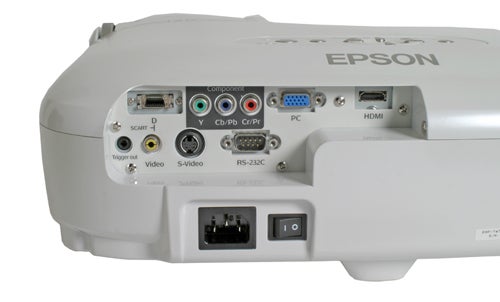
The unit itself is really quite attractive with a cream finish and plenty of good looking curves. There’s even a racy looking grille through which the heat from the lamp exhausts. It does shift quite a bit of heat so you shouldn’t put it in too enclosed a space. It also gave out a bit of a hot plastic smell, like a new car so I wouldn’t sit downwind of the vent either.
It feels well put together but I was actually surprised by how light it was – I was expecting it to be heavier. That said, at 5.4Kg, and dimensions of 310mm x 406mm x 124mm, it’s not a portable machine by any stretch – it’s intended for home use. The remote is curvy and doesn’t look that impressive, with slightly wobbly plastic buttons, but in fact it’s easy to use and comfortable to hold, with wide, spaced out buttons and a backlight that’s easily activated with a button at the bottom. It illuminates with a cool orange glow, though I wished it stayed on for a bit longer.
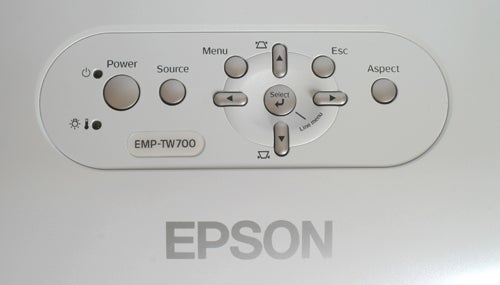
Connectivity is very good. There’s an HDMI port, HDCP compliant naturally, though having just the one means that you’ll need to use an HDMI switcher if you want to have a Sky HD box connected up at the same time as a PlayStation 3 and or a HD DVD player. You also get component and a VGA connector – but there’s no DVI, which is a shame. If you’re looking to hook up a media PC digitally then you’ll want to get an HDMI card and get that switcher. You’ll also get S-Video and composite to add to the flexibility and there’s also a 12V trigger and an RS232 serial port, used for custom control installations. The Japanese D4 connection isn’t actually completely useless – there’s a SCART adaptor in the box. This makes it easy to even hook up a VCR – though that would be like connecting a caravan to the back of an Aston Martin – deeply wrong.
The EMP-700 is delightfully easy to use. It turns on quickly and thanks to a clever lens system you can be flexible about where it’s placed. Two dials let you move the image left and right or up and down quickly so you don’t have to have the projector placed directly in front of the screen. However, the wheel movement wasn’t rock solid, and when moving it sideways the lens would suddenly drop down occasionally, so it took a bit of fiddling to get right. There’s a plastic cover for the lens, which will help keep the dust off when not in use. There’s easy to access keystone correction, but disappointingly I was never able to get a quite perfect oblong image.
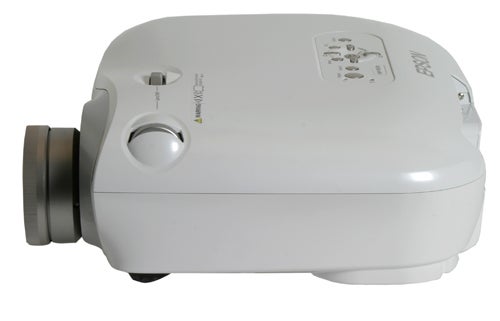
The menu system is intuitive, either from the remote or from the button panel on the top of the unit and has some quite detailed settings should you wish to really go in depth. There’s a basic sharpness setting but also an advanced mode with individual High Band, Low Band and Horizontal and Vertical settings – one for custom calibrators only I would think. Inside the menu you’ll also find gamma settings and there’s an Auto-Iris feature, which will automatically adjust brightness based on the content of the scene, opening and closing the lens slightly as it does so.
The main colour settings are perhaps the most crucial and likely to be used. There are seven modes in total, Dynamic, Living Room, Natural, Theatre, Theatre Black 1, Theatre Black 2and sRGB modes. Lamp life is given as 1,700 hours for all but the Theatre Black 1 and 2 modes, where it ups to 3,000 hours. There’s a direct control for these settings on the remote, which is a good thing, as you’ll be spending some time choosing which is the best to use depending on the content. With all the various settings you could easily spending a lot of time adjusting it to suit your room for a while before you can really settle down and start enjoying it. To help ease some of the pain there’s a memory setting so you can select the one you want depending on the content and conditions.
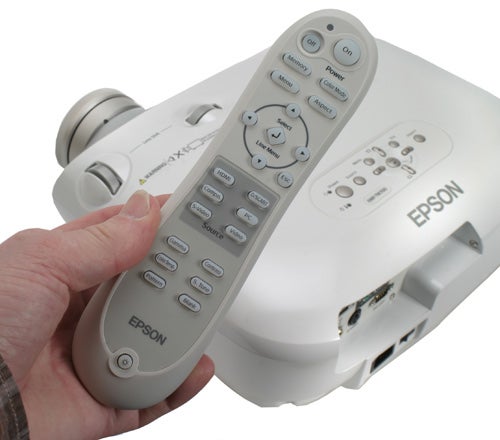
When it was first set-up, it was a bright day and it quickly became clear that if you want to watch in any kind of light, this isn’t the projector for you. Even on the brightest Dynamic setting it just wasn’t bright enough. Once it got darker the projector really started to show what it can do, but while there was pretty much any ambient light only the Dynamic setting was usable, which is a shame as the noise level was noticeable. However, the noise drops significantly in the other lower brightness modes.
Picture quality was good. The ‘chicken wire’ effect that affects some LCD projectors was entirely absent to my eyes. First up was some Xbox 360, with Gears of War, pumped straight in at 720p. Even using the dynamic setting, in the bright daylight it was hard to see the action. Once it got darker however, the quality began to shine though, with the sheer size of the image and the smoothness of the action impressing. Fast motion is something that this projector deals with very well.
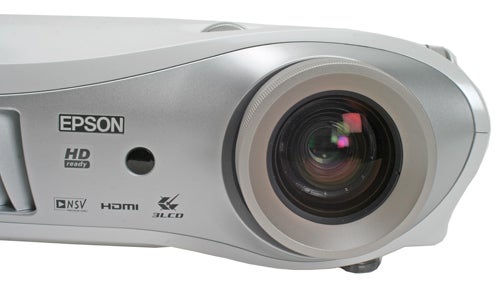
As the testing room got darker still we then switched to an HD DVD of King Kong and switched to the Living Room mode, which is best suited for rooms where there is some ambient light. King Kong is a big movie and we were soon drawn into the action, with bags of details visible in the gory dark scenes and the bright green foliage looking remarkably lush. When the room was properly dark we were looking forward to the screen really being able to show what it can do. Superman on HD DVD has dark scenes, fast action and bright colours in abundance and once we found the right colour mode, Natural, the images were very impressive indeed. The image was smooth and detailed, skin tones and the overall tonal balance was natural and accurate – it just looked right. However, though it was overall, easy on the eye colours couldn’t quite muster as much impact as I wanted, and black levels, while good, were again not as subtle or as deep as that of say, the Fujitsu Plasmavision P42XHA58 or of more expensive projectors.
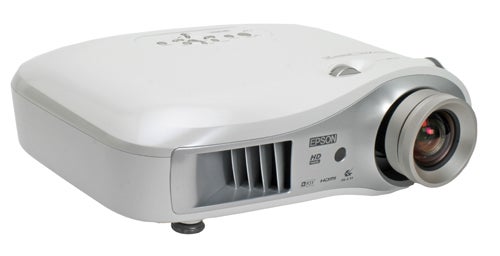
But that’s the crux of the matter. This projector will not set you back much that much more than a grand – and that’s a lot of projector for your money. If that’s your budget the Epson will certainly not disappoint, it’s very good, but I couldn’t help shake the feeling that I still wanted a bit more overall impact and even deeper blacks, which stops it just short of picking up an award. While I don’t think it’s quite good enough for a permanent set-up in a dedicated home cinema, if you’re looking for more casual big screen thrills for movies and games at a sensible price, this is a very strong contender.
”’Verdict”’
For the money the Epson’s delivers an awful lot – offering HD resolution and an HDMI port as well as component. It’s also very easy to set up and delivers smooth, detailed pictures. However, it needs a dark environment to get the best from it and even then colours are touch muted. Still, you’d be hard pressed to find better for the money.
How we test televisions
We test every TV we review thoroughly over an extended period of time. We use industry standard tests to compare features properly. We’ll always tell you what we find. We never, ever, accept money to review a product.
Trusted Score
Score in detail
-
Image Quality 8
-
Value 9

